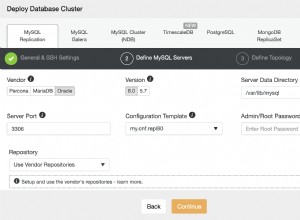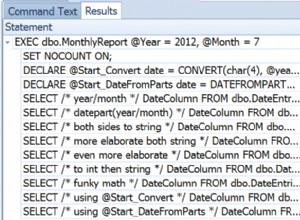select s.id,s.name,
max(case when e.course_id = 55 then complete else null end) as c55,
max(case when e.course_id = 66 then complete else null end) as c66,
max(case when e.course_id = 77 then complete else null end) as c77
from student as s
left join enrollment as e
on s.id = e.student_id
group by s.id
@Chris. Korzystając z procedury składowanej, możesz nawet utworzyć dynamiczną tabelę przestawną bez znajomości liczby kolumn. To jest link
http://forum.html.it/forum/showthread.php ?s=&threadid=1456236
odpowiedzi na podobny problem na włoskim forum. Istnieje kompletny przykład, który może pomóc w zrozumieniu stojącej za tym logiki. :)
EDYTUJ. Aktualizacja za pomocą MYSQL DYNAMIC VIEW
To jest mój startowy zrzut:
/*Table structure for table `student` */
drop table if exists `student`;
create table `student` (
`id` int(10) unsigned not null auto_increment,
`name` varchar(50) default null,
primary key (`id`)
) engine=myisam;
/*Data for the table `student` */
insert into `student`(`id`,`name`) values (1,'chris');
insert into `student`(`id`,`name`) values (2,'joe');
insert into `student`(`id`,`name`) values (3,'jack');
drop table if exists enrollment;
create table `enrollment` (
`enrollment_id` int(11) auto_increment primary key,
`student_id` int(11) default null,
`course_id` int(11) default null,
`complete` varchar(50) default null
) engine=myisam auto_increment=8 default charset=latin1;
/*Data for the table `enrollment` */
insert into `enrollment`(`enrollment_id`,`student_id`,`course_id`,`complete`) values (1,1,55,'true');
insert into `enrollment`(`enrollment_id`,`student_id`,`course_id`,`complete`) values (2,1,66,'true');
insert into `enrollment`(`enrollment_id`,`student_id`,`course_id`,`complete`) values (3,1,77,'true');
insert into `enrollment`(`enrollment_id`,`student_id`,`course_id`,`complete`) values (4,2,55,'true');
insert into `enrollment`(`enrollment_id`,`student_id`,`course_id`,`complete`) values (5,2,66,'false');
insert into `enrollment`(`enrollment_id`,`student_id`,`course_id`,`complete`) values (6,3,55,'false');
insert into `enrollment`(`enrollment_id`,`student_id`,`course_id`,`complete`) values (7,3,66,'true');
a to jest procedura składowana dla widoku dynamicznego:
delimiter //
drop procedure if exists dynamic_view//
create procedure dynamic_view()
begin
declare finish int default 0;
declare cid int;
declare str varchar(10000) default "select s.id,s.name,";
declare curs cursor for select course_id from enrollment group by course_id;
declare continue handler for not found set finish = 1;
open curs;
my_loop:loop
fetch curs into cid;
if finish = 1 then
leave my_loop;
end if;
set str = concat(str, "max(case when e.course_id = ",cid," then complete else null end) as course_",cid,",");
end loop;
close curs;
set str = substr(str,1,char_length(str)-1);
set @str = concat(str," from student as s
left join enrollment as e
on s.id = e.student_id
group by s.id");
prepare stmt from @str;
execute stmt;
deallocate prepare stmt;
-- select str;
end;//
delimiter ;
Teraz nazwijmy to
mysql> call dynamic_view();
+----+-------+-----------+-----------+-----------+
| id | name | course_55 | course_66 | course_77 |
+----+-------+-----------+-----------+-----------+
| 1 | chris | true | true | true |
| 2 | joe | true | false | NULL |
| 3 | jack | false | true | NULL |
+----+-------+-----------+-----------+-----------+
3 rows in set (0.00 sec)
Query OK, 0 rows affected (0.05 sec)
Teraz wstawiamy kolejne dwa rekordy z dwoma różnymi kursami:
insert into `enrollment`(`student_id`,`course_id`,`complete`) values (1,88,'true');
insert into `enrollment`(`student_id`,`course_id`,`complete`) values (3,99,'true');
i przypominamy procedurę. Oto wynik:
mysql> call dynamic_view();
+----+-------+-----------+-----------+-----------+-----------+-----------+
| id | name | course_55 | course_66 | course_77 | course_88 | course_99 |
+----+-------+-----------+-----------+-----------+-----------+-----------+
| 1 | chris | true | true | true | true | NULL |
| 2 | joe | true | false | NULL | NULL | NULL |
| 3 | jack | false | true | NULL | NULL | true |
+----+-------+-----------+-----------+-----------+-----------+-----------+
3 rows in set (0.00 sec)
Query OK, 0 rows affected (0.02 sec)
To wszystko. :)




